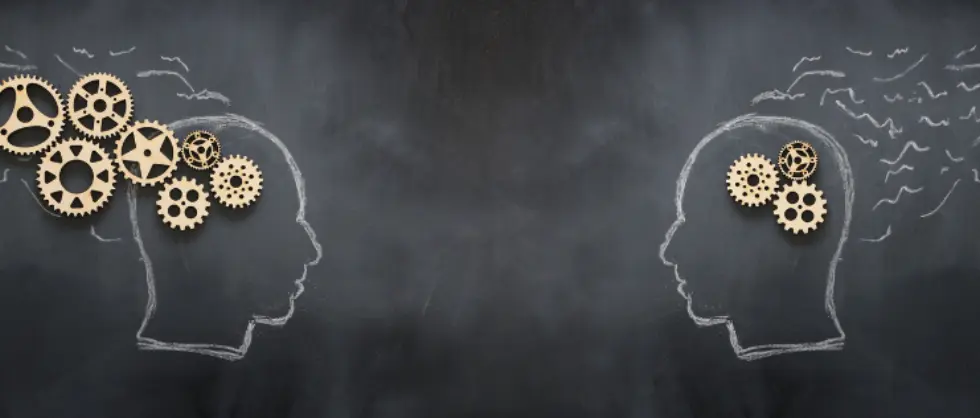Navigating the complexities of mental health and relevant conditions can often feel like trying to solve a puzzle without all the pieces. Where symptoms fit into the big picture can often feel overwhelming, and distinguishing between conditions like ADHD and Anxiety, where symptoms overlap, is challenging.
ADHD and Anxiety are both conditions that may affect concentration, behavior, and emotional regulation. While they often share symptoms, their root causes and how they are treated differ significantly. ADHD is characterized by persistent inattention, hyperactivity, or impulsivity, affecting an individual’s academic, work, and personal lives. In contrast, Anxiety involves heightened worry and fear, often leading to physical symptoms and, in some cases, affecting quality of life.
Understanding the nuanced differences between ADHD and Anxiety is crucial for accurate diagnosis and effective treatment. In this article, we will explore their causes, their similarities, how they’re diagnosed, and treatment strategies for individuals looking to empower their lives and take control of their mental health.
Understanding ADHD
Attention Deficit Hyperactivity Disorder (ADHD) is a neurodevelopmental disorder characterized by persistent inattention, hyperactivity, or impulsivity in a way that interferes with development and day-to-day activities.
ADHD is predominantly identified in children and results from a combination of genetic, neurobiological, and environmental factors. Research indicates that genetics plays a significant role in the development of ADHD, with the condition commonly running in families.
Neurobiological (meaning “mind-body”) factors include variations in specific brain structures and neurotransmitter (brain chemical) levels. These variations affect attention, impulse control, and activity levels.
The prevalence of ADHD diagnoses in children is partly because it’s easier to notice symptoms in educational and social settings, where inattention and hyperactivity contrast with expected behavior. Children with ADHD may have trouble focusing on activities, following instructions, or staying seated.
Understanding the causes of ADHD underscores the importance of diagnosis and treatment. These treatments are primarily determined by an individual’s symptoms and which subtype of ADHD they are diagnosed with.
ADHD DSM-V Symptoms and Diagnosis
ADHD symptoms can be broadly categorized into two main areas: inattention and hyperactivity-impulsivity. Individuals are primarily diagnosed as one of three subtypes: predominantly inattentive, predominantly hyperactive-impulsive, and combined presentation, a mix of the first two subtypes.
Children with inattention difficulties may:
- Struggle to maintain focus on tasks or play activities.
- Make careless mistakes and fail to give attention to close details.
- Move quickly from one interest to another without completion.
- Appear not to listen when spoken to.
- Have difficulty with organizing tasks and activities.
- Be prone to losing things necessary for tasks or activities.
Hyperactivity and impulsivity refer to excessive fidgeting, talking, and an inability to remain seated or still in certain situations, such as in a classroom or while at a restaurant. Children might
- Run or climb in non-play areas,
- Have trouble playing quietly,
- Act without regard for consequences,
- Talk excessively,
- Be impatient and have trouble waiting,
- Blurt out answers or phrases out of turn.
Diagnosing ADHD involves a thorough evaluation by a healthcare professional, often including input from parents, teachers, and others close to the child. According to the DSM-V, individuals must meet the following conditions to meet diagnosis.
- Have at least six symptoms of
- Inattention for the first sub-type.
- Hyperactivity and impulsivity for the second sub-type.
- Have a sufficient combination of symptoms of the above categories for Combined Presentation.
- For adults age 17 or older, the threshold number of symptoms to meet diagnosis is five, rather than six.
- Symptoms must have been present for at least six months and not appropriate for the individual’s current level of development. (i.e., not acting one’s “age”)
- Symptoms seriously disrupt life and daily functioning.
- Symptoms were present in individuals before the age of 12.
- Several symptoms show in multiple locations (e.g., at work and home).
- The symptoms are not part of or wholly attributable to another mental health condition.
Because of the impact ADHD can have on an individual’s well-being and daily life, early diagnosis and intervention are crucial. Early intervention helps children achieve their full potential through tailored treatment plans that may include therapy, medication, and educational support.
Understanding Anxiety
When we refer to Anxiety as a mental health condition, we’re typically referring to Generalized Anxiety Disorder, but it represents a class of conditions that have similar symptoms.
Anxiety Disorders include several conditions with symptoms of fear, worry, and nervousness that are consistent and significantly interfere with daily activities. Unlike the everyday stress that everyone experiences, anxiety disorders persist and can worsen over time.
Life experiences, such as trauma or significant stress, can trigger or worsen anxiety disorders, as can certain personality types that are more prone to Anxiety. Neurobiological factors, such as imbalances in neurotransmitters like serotonin and dopamine, also contribute to their development.
Unlike ADHD, it is more common for Anxiety Disorders to arise later in life, especially after stressful or traumatic events. Adults may also carry more Anxiety or have more awareness of stressful life conditions (such as lack of money, environmental or social concerns, etc.) that can contribute to their Anxiety over time.
Anxiety Types and Signs
Anxiety Disorders encompass a variety of conditions, each with its own specific symptoms and triggers, but all are characterized by excessive and persistent worry and fear.
Common anxiety disorders include:
-
- Generalized Anxiety Disorder (GAD): Characterized by chronic, exaggerated worry about routine life events and activities. This condition is what is most commonly referred to as simply “anxiety” or “having anxiety.” Symptoms include:
- Restlessness
- Fatigue
- Difficulty concentrating
- Irritability
- Muscle tension
- Difficulty sleeping
- Panic Disorder: Features sudden or intense episodes of fear or discomfort, known as panic attacks. Individuals avoid places or situations that might trigger these attacks. Symptoms can include:
- Palpitations
- Sweating
- Trembling
- Shortness of breath
- Fear of impending doom or losing control
- Social Anxiety Disorder: Characterized by fear of social or performance situations where there’s a threat of negative social evaluation. This includes public speaking or social gatherings and can lead to avoidance of those situations.
- Specific Phobias: Includes intense, persistent fears of specific objects or situations, such as spiders, flying, enclosed spaces, or receiving injections. Similar to other anxiety disorders, this fear can lead to avoidance of triggers.
Overall, symptoms of anxiety disorders include:
- Persistent worry or fear that interferes with daily activities
- Avoiding situations due to fear
- Physical symptoms like rapid heartbeat, fatigue, headaches, or nausea
- Difficulty sleeping due to worry
- Difficulty controlling feelings of worry
- Feeling restless, wound-up, or on-edge
Key Differences Between ADHD and Anxiety
Despite the overlap in some of their symptoms, such as difficulty concentrating and restlessness, ADHD and Anxiety are separate conditions that require different treatment strategies and represent separate root causes.
Recognizing these differences is crucial for providing the proper support and interventions, as both ADHD and Anxiety Disorders can profoundly affect an individual’s quality of life, albeit through different causes and symptoms.
The Nature of Attention Issues
ADHD is marked by inattention, hyperactivity, and/or impulsivity.
These challenges are neurodevelopmental, linked to differences in brain function that impair the ability to sustain attention, control impulses, and manage activities effectively. Individuals with ADHD may find it hard to stay focused on tasks, frequently switch from one activity to another without completion, and struggle with organizing and prioritizing tasks.
Conversely, in anxiety disorders, attention issues result from excessive worry and fear. The mind becomes preoccupied with anxious thoughts, leading to difficulty concentrating on the task at hand.
People with Anxiety may find themselves unable to focus because their thoughts are consumed by potential future problems, fears, or hypothetical scenarios, diverting their attention away from immediate tasks.
For more information, check out this informative article:
When are Attentional Problems not ADHD?
Emotional Responses and Triggers
ADHD is characterized by neurodevelopmental factors that affect self-regulation, leading to emotional responses that can be intense and impulsive. Individuals with ADHD may exhibit frustration, impatience, or mood swings when faced with tasks that require sustained attention or when they feel overwhelmed.
In contrast, Anxiety Disorders are primarily driven by excessive fear and worry about future events, potential threats, or perceived dangers. Emotional responses in anxiety disorders include feelings of nervousness or panic in anticipation of specific situations or sometimes without an identifiable trigger.
These responses are rooted in the body’s fight-or-flight mechanism but are provoked out of context. Individuals with anxiety also often have physical symptoms of emotional distress.
Physical Symptoms: Hyperactivity vs Tension
In ADHD, hyperactivity is one of the core symptoms, especially in the predominantly hyperactive-impulsive presentation. It is manifested through a constant need for movement, an inability to stay still, fidgeting, tapping, or talking excessively.
Conversely, anxiety disorders are characterized by physical tension, a manifestation of the body’s response to stress and fear. Physical symptoms can include:
- Muscle tightness
- Headaches
- Stomachaches
- A feeling of being on edge
- Rapid heart rate
The physical symptoms of anxiety are direct outcomes of the body’s fight-or-flight response, activated even in the absence of actual danger, leading to a state of heightened physical readiness that can be exhausting and interfere with daily activities.
Similarities Between ADHD and Anxiety
Despite the distinct differences between ADHD (Attention Deficit Hyperactivity Disorder) and anxiety disorders, there are notable similarities that can sometimes complicate diagnosis and treatment. Both conditions can adversely affect individuals’ ability to function in daily life, including academic performance, work productivity, and social interactions.
Below are symptoms that overlap between ADHD and Anxiety and how they interact with their respective conditions:
- Difficulty Concentrating: Individuals with ADHD often struggle with concentrating due to inattention and distractibility. Similarly, those with anxiety may find their concentration distracted by persistent worries and fears.
- Restlessness: For those with ADHD, hyperactivity and an inner sense of restlessness are common. In Anxiety Disorders, physical tension and chronic worry can manifest as restlessness, leading individuals to feel unable to relax or stay still.
- Sleep Disturbances: Individuals with ADHD may have difficulty falling asleep or experience interrupted sleep because of hyperactivity. Anxiety can also disrupt sleep patterns, with worries and fears making it hard to fall or stay asleep. Individuals with either condition may lose sleep due to intrusive thoughts.
- Emotional Dysregulation: ADHD is associated with impulsivity and difficulty managing emotional responses, resulting in temper flares or heightened frustration. Anxiety, on the other hand, can lead to feelings of nervousness, panic, or excessive worry, which can be overwhelming and difficult to control.
Here is a table comparing the symptoms of ADHD and Anxiety Disorders:
Characteristic ADHD Anxiety Concentration Difficulty maintaining focus on tasks, easily distracted. Difficulty concentrating due to worries. Restlessness Physical restlessness, fidgeting, inability to stay still. Psychological restlessness, feeling “on edge.” Trouble Sleeping Trouble falling asleep or restless sleep due to hyperactivity. Difficulty sleeping due to worry, fears, or intrusive thoughts. Emotional Dysregulation Quick to frustration, impulsive emotional reactions, mood swings. Intense worry, fear, or panic that is difficult to control. Quality of Life Impact on academic, social, and occupational functioning. Avoidance of anxiety-provoking situations. Prevalence Rate 2.5-6.7% Adults
19% of Adults
(Any Anxiety Disorder)Average Age of Onset Typically early childhood, usually by age 7. Varies widely, but often emerges during late childhood to early adulthood. Diagnosing ADHD and Anxiety
Diagnosing ADHD (Attention Deficit Hyperactivity Disorder) and anxiety disorders requires a careful and thorough evaluation process, as both conditions can present similar symptoms, such as restlessness and difficulty concentrating. However, the approaches to diagnosing each condition vary due to their distinct characteristics.
The diagnosis of ADHD is made based on the clinical criteria established by the DSM-V and is made by a healthcare provider, often a psychologist or psychiatrist. The healthcare provider gathers information, including patient’s self-reports, family members’ observations, and school or work reports to make their diagnosis.
Anxiety disorders are also diagnosed based on criteria from the DSM-5, but the focus here is on the presence of excessive worry and stress across several topics, events, or activities. Anxiety and worry are challenging to control and can impair the quality of life and the ability to engage in social experiences.
Can I Be Diagnosed With Both ADHD and Anxiety?
One of the challenges in diagnosing these conditions is the symptom overlap, such as difficulty with focus and restlessness, which can occur in both ADHD and various anxiety disorders. Additionally, an individual can have both conditions concurrently, known as comorbidity, which can complicate the diagnostic process.
In both cases, a comprehensive assessment often includes standardized questionnaires or checklists, psychological testing, and sometimes physical examinations to rule out other conditions.
An accurate diagnosis is essential as it directs the course of treatment. ADHD may be managed with medication, behavioral interventions, and lifestyle changes, while anxiety disorders are commonly treated with psychotherapy, medication, stress reduction techniques, and also lifestyle modifications.
For more information, check out this video:
How do I know if I have ADHD? What if I also have symptoms of anxiety and/or depression?Treatment Strategies for ADHD and Anxiety
The treatment strategies for ADHD (Attention Deficit Hyperactivity Disorder) and anxiety disorders are tailored to address the specific symptoms and challenges of each condition. While there are distinct approaches for each, they can also overlap, particularly in cases where a patient may be experiencing both conditions concurrently.
Treatment for ADHD
ADHD treatment typically involves a multi-faceted approach. The most common and well-supported treatments include:
- Cognitive Behavioral Therapy (CBT): This involves working with a therapist to develop skills and strategies to manage the behavioral aspects of ADHD, such as organization, planning, and impulse control.
- Educational Interventions: These are strategies implemented in school or work environments to help manage ADHD symptoms and improve daily functioning. Examples include planners, breaking tasks into smaller steps, and providing structured routines.
- Lifestyle Modifications: Regular exercise, consistent sleep, and a healthy diet can also impact overall quality of life, help build routines, and help manage ADHD symptoms.
- Medication: Stimulant medications are the most widely used treatment for ADHD and work by increasing the levels of certain neurotransmitters in the brain. Non-stimulant medication is also available. These medications help increase focus and manage impulsivity.
Treatment for Anxiety
Anxiety disorders are generally treated with psychotherapy, medication, or a combination of both:
- Cognitive Behavioral Therapy: CBT stands out as a highly effective treatment for anxiety disorders. It helps individuals recognize and confront the detrimental thought processes and actions contributing to their anxiety.
- Relaxation Techniques: Deep breathing, meditation, and progressive muscle relaxation are all practices that can help alleviate the physical symptoms of anxiety.
- Medication: Antidepressants, including SSRIs and SNRIs, are commonly prescribed for Anxiety. Benzodiazepines (e.g,. Xanax) may also be used for short-term relief of severe anxiety symptoms.
Begin Your Journey to Support and Understanding with Start My Wellness
With all of the information about mental health conditions available today, it can be difficult navigating symptoms, with each condition presenting unique challenges and requiring specialized treatment approaches.
Early intervention, informed by accurate diagnosis, can make a substantial difference in individuals’ quality of life and the effectiveness of their treatment. With the right resources and guidance, individuals dealing with ADHD, Anxiety, or both can find pathways to not just cope but thrive.
If you or someone you know is struggling with ADHD or anxiety, remember that help is available, and you don’t have to face these challenges alone. Begin your journey to support and understanding with Start My Wellness today, and take a decisive step towards empowerment, health, and well-being.
Call us today at 248-514-4955 to start your journey to wellness.
Sources
- National Institute of Mental Health: Attention-Deficit/Hyperactivity Disorder
- CDC: Symptoms and Diagnosis of ADHD
- Start My Wellness: Anxiety vs Stress: What am I Feeling?
- ADD Association: The Difference Between ADHD and Anxiety in Adults
- Start My Wellness: The Overlap Between ADHD and Intrusive Thoughts
- National Library of Medicine: ADHD Diagnostic Trends: Increased Recognition or Overdiagnosis?
- National Institute of Health: Any Anxiety Disorder
- Start My Wellness: Different Methods of Diagnosing ADHD
- Start My Wellness: ADD and ADHD Counseling
- Start My Wellness: Anxiety and Depression Counseling
- Start My Wellness: Types of Anxiety Therapies
- Generalized Anxiety Disorder (GAD): Characterized by chronic, exaggerated worry about routine life events and activities. This condition is what is most commonly referred to as simply “anxiety” or “having anxiety.” Symptoms include:

Author: Anton Babushkin, PhD
Looking for a Therapist? Start My Wellness has highly experienced Licensed Therapists that are currently accepting new patients.


